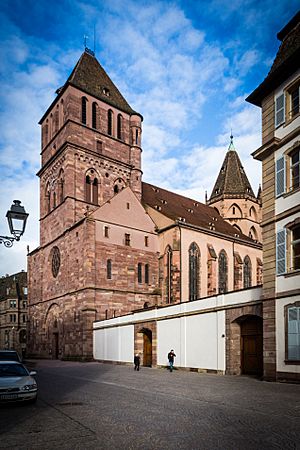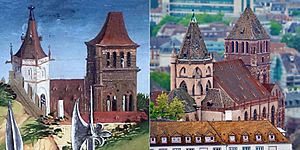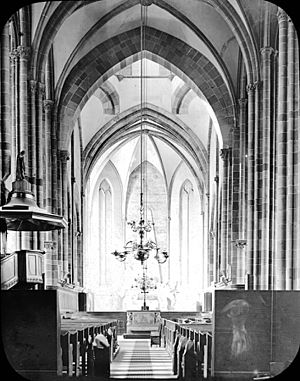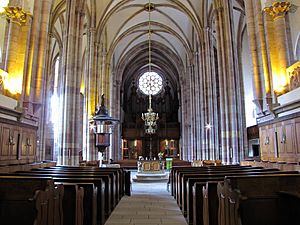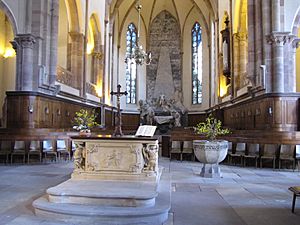St Thomas' Church, Strasbourg facts for kids
St Thomas' Church (also known as Église Saint-Thomas in French or Thomaskirche in German) is a very old and important building in Strasbourg, a city in eastern France. It is the main Lutheran church in Strasbourg. This happened after the city's main cathedral became Catholic again in 1681.
People sometimes call St Thomas' Church the "Protestant Cathedral" or the "Old Lady." It is special because it's the only example of a hall church in the Alsace region. A hall church means all the main parts inside are about the same height. The church is located on the Route Romane d'Alsace, a famous route for old Romanesque buildings. The French government has listed it as a Monument historique (a historic monument) since 1862.
Contents
History of St Thomas' Church
The place where St Thomas' Church stands has been used for worship for a very long time. People were worshipping here as early as the 500s. The church is named after Thomas the Apostle.
Early Buildings and Fires
In the 800s, a bishop named Adelochus built a beautiful church and a school here. Sadly, both buildings burned down in 1007. They were rebuilt but burned down again in 1144.
Building the Current Church
In 1196, work started on the front of a new church. It was built like a strong fortress with a tall steeple. This part was in the Romanesque style, which uses round arches and thick walls. Building stopped and started many times. The church was finally finished in 1521. The later parts were built in the Gothic style, which has pointed arches and large windows.
Around 1450, the church asked for a series of paintings about the Passion of Jesus. These paintings showed the story of Jesus's suffering. Most of these paintings are now in a museum in Karlsruhe, Germany. The artist who painted them is known as the "Master of the Karlsruhe Passion." One of his paintings shows St Thomas' Church looking much like it does today.
Becoming a Protestant Church
In 1524, St Thomas' Church changed from being Catholic to Protestant. This was a big change for the church. A famous Protestant leader named Martin Bucer worked there as a Pastor. Even when Alsace became part of Catholic France, the church stayed Protestant.
Today, the church still runs schools like École Saint-Thomas and Foyer Jean Sturm. It also has a seminary, which is a school for training pastors, called the Séminaire Protestant. This seminary is in a Baroque building next to the church.
Important Events
St Thomas' Church was very important for developing new ways of church service. From 1888, Friedrich Spitta tried out new ideas there. The "Academic Chorus" (Akademische Kirchenchor) also started at this church. Between 1894 and 1899, a new hymn book for the Alsace-Lorraine region was created here.
On May 7, 2006, a special ceremony took place at the church. It celebrated the creation of the "Union of the Protestant Churches of Alsace and Lorraine" (UEPAL).
Church Architecture
St Thomas' Church is a five-naved hall church. This means it has a main central area and four side aisles, all roughly the same height. It is the oldest hall church in what used to be southwest Germany.
Inside, the church is about 65 meters (213 feet) long and 30 meters (98 feet) wide. The main part of the church is 22 meters (72 feet) high. Under the late-Gothic cupola (a rounded roof or dome), it is 30 meters (98 feet) high. There is a balcony, or gallery, on the left side. There are also small chapels on both sides of the apse, which is the rounded end of the church.
Special Features of the Church
Famous Organs
The church is known around the world for its amazing and historic organs.
- Silbermann Organ: One organ was built in 1741 by Johann Andreas Silbermann. The famous composer Wolfgang Amadeus Mozart played this organ in 1778! It was carefully restored in 1979. A French organist named Louis Thiry even recorded music by Johann Sebastian Bach on this organ.
- Choir Organ: The other organ was built in 1905. It was designed by the famous organist and doctor Albert Schweitzer.
Important Tombs
Many monuments and tombs are found in the church, dating from 1130 to 1850.
- Bishop Adelochus's Sarcophagus: The most famous tomb is the beautifully decorated sarcophagus (a stone coffin) of Bishop Adelochus. It was made around 1130.
- Marshal Maurice de Saxe's Mausoleum: Another very famous monument is the large, fancy mausoleum (a grand tomb) of Marshal Maurice de Saxe. It was created in 1777 by a sculptor named Jean-Baptiste Pigalle.
- Nikolaus Roeder von Tiersberg's Tombstone: Among other notable monuments, there is a Renaissance tombstone from 1510 for Nikolaus Roeder von Tiersberg. It shows a very realistic image of his body.
Old Frescos
A large Fresco (a painting done on wet plaster) of Saint Michael is in the church. It was probably painted by Jost Haller. It is one of the biggest frescos of its kind in France.
Stained-Glass Windows
Only the round rose window at the front of the church remains from the medieval period. In the main part of the church, the upper parts of the windows have beautiful designs of buildings and plants. The images of saints that used to be below these designs were destroyed in the 1500s. This happened during a time called iconoclasm, when people believed that religious images should not be worshipped. The windows in the choir area are in a more modern style.
Gallery
-
The choir organ, built in 1905 following plans by Albert Schweitzer.
-
The sarcophagus of Bishop Adeloch.
-
A fresco painting of Saint Michael.
-
The mausoleum of Marshal Maurice de Saxe by Jean-Baptiste Pigalle.


